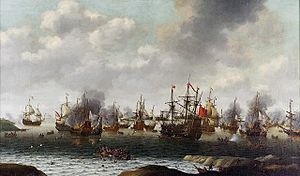Anglo-Dutch Wars facts for kids
Quick facts for kids Anglo-Dutch Wars |
|||||||
|---|---|---|---|---|---|---|---|
 Dutch attack on the Medway during the Second Anglo-Dutch War by Pieter Cornelisz van Soest, c. 1667. |
|||||||
|
|||||||
| Belligerents | |||||||
| Commanders and leaders | |||||||
| Strength | |||||||
| Dutch Republic 600 warships 1,500 Marines 50 soldiers Denmark–Norway Fortress, 250 soldiers |
England 650 warships 300 soldiers France 60 ships |
||||||
| Casualties and losses | |||||||
| Dutch Republic 56 warships lost 20 warships captured 10,150 dead 20,000 wounded 2,500 captured Denmark–Norway 8 dead 10 civilians killed |
England 40 warships lost 18 warships captured 13,310 dead 25,000 wounded 2,000 captured France 400 killed |
||||||
The Anglo-Dutch Wars ([Engels–Nederlandse Oorlogen or Engelse Zeeoorlogen] Error: {{Lang-xx}}: text has italic markup (help)) were a series of wars fought between the English and the Dutch during the 17th and 18th centuries. The two nations fought for control over trade routes on the seas. All of the wars were mostly fought by the countries' navies.
The First War (1652–1654) took place during the Interregnum in England, the period after the Civil War when England did not have a king or queen. The war was fought between the navies of England and the Dutch Republic (also known as the United Provinces). It mainly took place in the English Channel and the North Sea. It ended with the English Navy gaining control of these seas and a monopoly over trade with the English colonies.
The second (1665–1667) and third (1672–1674) wars happened after the English Restoration of the monarchy. England tried to end the Dutch monopoly over world trade. Most of the fighting in both wars was done in the North Sea. In the Third War, England fought alongside France. Both of these wars ended in strong victories for the Dutch. They confirmed the Dutch Republic's position as the leading maritime power of the 17th century.
The Fourth War (1780–1784) took place after the Acts of Union in Britain, and involved the Dutch Republic and the Kingdom of Great Britain. It mainly started because Britain disagreed with the Dutch trading with the United States during the American Revolutionary War. The war ended with the Treaty of Paris (1784). It ended with a very bad defeat for the Dutch. They lost parts of their Dutch Empire.
Related pages
Images for kids
-
Dutch factory at Ambon, early to mid-17th century
-
The Battle of Leghorn, 4 March 1653
-
The Battle of Scheveningen, 10 August 1653
-
The Battle of Solebay, 7 June 1672
-
The capture of Sint Eustatius by the British fleet in 1781. The island is sacked by the British.
See also
 In Spanish: Guerras anglo-neerlandesas para niños
In Spanish: Guerras anglo-neerlandesas para niños






